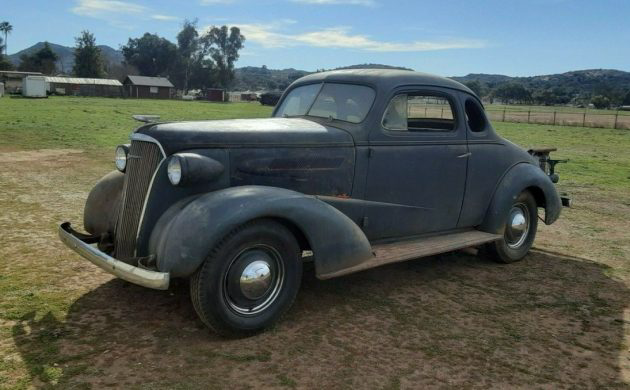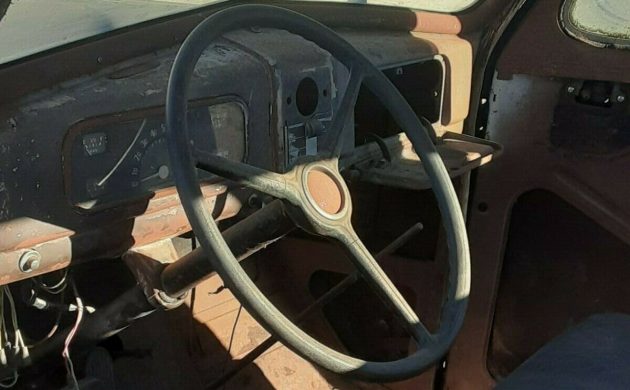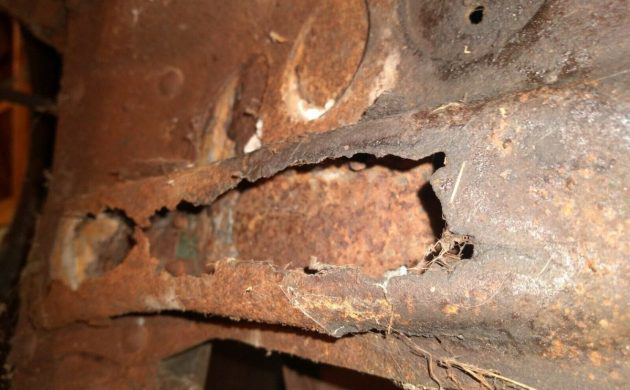Rare Survivor: 1937 Chevrolet Master Coupe Pickup
Two decades before the Ford Ranchero and the Chevrolet El Camino debuted, the Great Depression meant that for many Americans, money was tight. Families needed to stretch their dollars as far as they could, and buying a vehicle was no exception. Enter the Chevrolet Coupe Pickup. The idea was obvious, combine the style of a coupe and the utility of a pickup into one package. This 1937 Chevrolet Master Deluxe Coupe Pickup is a rare surviving example of that. Located in Spring Valley, California, the car is up for auction here on eBay with a very large group of watchers but few bids. These cars rarely have the accessory pickup bed still with the vehicle, many beds having been discarded in later decades. That makes this coupe a very rare and interesting example of America’s attempts to create a passenger car-based utility vehicle similar to the Australian Ute and later American Ford Ranchero and Chevy El Camino.
The Ute concept has a long history, dating back to the first pickup trucks based on passenger car chassis such as the Model T Roadster Pickup. Other companies had similar offerings for sale. Into the 1930s, passenger cars and pickups began to diverge. Pickup trucks became the norm, built on heavier chassis than passenger cars and with markedly fewer amenities. In Australia, the Ute (short for utility) was created after a farmer’s wife wrote a letter to Ford Australia asking, “Why don’t you build people like us a vehicle to go to church in on a Sunday, and which can carry our pigs to market on Mondays?” This letter came apparently after the farm truck’s bumpy ride had dirtied the wife’s clothes one too many times on the drive, and the family didn’t have the money to have two cars. Thus, in 1934, Ford Australia came out with Ford Coupe Utility 302, and Australia began its love affair with the Ute.
The Chevrolet Master Coupe Pickup comes from a similar desire to have the utility of a pickup with the driveability of a car for families or businesses that couldn’t afford a vehicle for each. Chevrolet first introduced the model in 1936. Also known as the Foreman’s Pickup, this was a business coupe with an attached pickup bed where the trunk would be otherwise. 1937 was the first year you could remove the bed and attach a trunk lid. This model was offered until 1942 when production ceased due to WWII. In total, approximately 10,000 of these cars were made between 1936 and 1942, with the majority built between 1936-1938. During the war, these vehicles were even more useful, as due to the pickup bed, owners could get a commercial gas ration stamp. The cars were popular with farmers, construction workers, and small groceries that made deliveries.
This Coupe Pickup is one of the very few that have survived as designed, with their pickup bed. It still has the original 216 c.i.d. six-cylinder engine and three-speed transmission, though the current owner has not started it. This one even appears to be a Master Deluxe, the higher trim level and has the optional radio, heater, and twin horns. It also has updated but period sealed beam headlights. Inside, the interior is complete but rough. The seat looks to be in fine condition but given the rest of the interior, a new buyer would probably redo everything, seats included. The seller states it is a California car, though, with the decent amount of cancerous rust the car has, it might have lived further North than Spring Valley, California. Indeed, the corrosion is considerable in some areas. Both doors, the quarter panels, and the radiator support have major rust issues that would have to be addressed by any new owner.
All together this car is a great candidate for restoration. Given the rarity, the condition of the car, and the decent availability of parts, this car is a no brainer. As a forerunner of the popular and famous El Camino, this Chevy would be right at home in any car show and would surely attract lots of attention and questions. With that said, the generations who drove and used these cars daily are no longer really buying cars. I only hope the next owner restores this car and keeps it original. Resto mods and hot rods are great, but this old workhorse would stay the way it was designed, as a comfortable car that can perform utilitarian tasks as well. What do you think? Is this Coupe Pickup something you would add to your collection?
Auctions Ending Soon
 2006 Ford Mustang Saleen S281 SCBid Now9 hours$15,000
2006 Ford Mustang Saleen S281 SCBid Now9 hours$15,000
 2002 Subaru Impreza WRXBid Now3 days$333
2002 Subaru Impreza WRXBid Now3 days$333
 1975 Chevrolet Corvette ConvertibleBid Now3 days$3,000
1975 Chevrolet Corvette ConvertibleBid Now3 days$3,000
 1964 Ford F-100 Camper CustomBid Now3 days$2,000
1964 Ford F-100 Camper CustomBid Now3 days$2,000
 2006 Jeep Wrangler SportBid Now5 days$10,500
2006 Jeep Wrangler SportBid Now5 days$10,500






Comments
Got to agree, too cool to hotrod. Going to be a sharp ride restored. I have seen quite a few field and barn cars when I was stationed in N.Dakota many moons ago and didn’t know these existed. Got my 40 ford and some cool parts back then. Got a Columbia rear axle out of a 48 quite cheap. Back to the chevy very cool.
The pickup coupe was built on the Master chassis.
The images of the trunk/bed are from two different vehicles. One shows an empty bed with metal sides with a wood floor. The other image shows a radio, a heater, and a tire in in a trunk with a metal floor.
The seller did auction a Master Deluxe in the last six months so it’s probably a simple error. Even so anyone interested should check the status of the radio and heater.
I did mention the bed was removable. You can tell they are the same vehicle from the rolls on the edges of the trunk featured in the long shot of the bed and the shot with the spare and accessories. The tray is what the removable bed rests on.
I remember seeing one of these at a car show around 30 years ago here in Ohio. Initially I thought it was homemade but after talking with the owner, I found out that this is the way it came from the factory. Crude but functional.
There were hundreds of these still running around in Southern Rhodesia (Zimbabwe) back in the 50’s. They were mainly American Fords, Chevs, Plymouths and British Ford V8 Pilots lot’s of which were converted into pickups.
This is a “trunk accessory” that one could buy. Studebaker had a pickup box one could buy to turn your car into a pickup. They did not come from the factory like this, it was an accessory.
Actually, it was a purchase-able model you could order. If you look it up, there are multiple examples of advertisements by Chevy of the model. Additionally, in the coupe pickup, the spare had a dedicated compartment built in, which you can see under the tray.
My 38 buick trunk back sedan stored the spare in the same place under the trunk floor…
Farmer in my neighborhood where I grew up did a similar conversion on his 37 Buick special coupe.. Used to bring the milk cans to the street from the barn… Loved that car.. After he passed a young friend of the lawyer that handled the estate got the car and used to haul his go-kart in it… The straight eights had a distinctive sound… I actually ended up getting a 38 Special sedan as my first old car, I was about 20 years old in 72… Had that sweet sedan about nine years… One that got away…
So many collectors haven’t a clue that cars from 1938 to 1943 were converted to utility use as part if their good-time / war time history. This is a living example of real time history. A real workhorse.
The pickup aspect aside, that Chev. has stunning lines and proportions. And being a ’37 it’s all steel, a huge item to consider. A ’36 is still a wooden car requiring major disassembly and r&r should there be rot issues. I learned this terrible lesson on a 1929 Pontiac I bought in 1960 at age 14, and still have. Any GM fisher body earlier than ’37- beware! Shortly after acquiring my Pontiac, I came across a ’37 Chrysler Royal (all steel) and like Charles Groden on his honeymoon in The Heartbreak Kid upon meeting Cybil Shepard, realizes: OMG! this was the girl I was suppose to marry!
My first car in the mid 60’s was a ’37 Chev “Businessman” coupe when I was 16. Paint a bit faded but it ran like a top. I bought it from the original owner. Sold it so I could put new tires and a battery in my next car, a ’35 Ford 5 window coupe. Now also long gone. “too late smart”. Stay well everyone.
This model was known officially as the Chevrolet Foreman. It was intended for use by contractors and building trades people. It was produced from 1936 to 1941 but never quite caught on.
Have heard several times that part of the reason these were popular was that then, like now, taxes were cheaper on trucks than cars, so……
All came in blue with wood beds. If anyone needs one. Hit me up.
I only need 1 seat. Hack the rest off for a bigger bed –
I only need 1 seat. Hack the rest off for a bigger bed –
Maybe it isn’t obvious to everyone who looks at the car, but they made these by leaving off the trunk lid and putting that pickup tray in the trunk. Prior to World War II they were typically business coupe models like this with no backseat and a larger trunk – used by salesman or people delivering orders
Wow! Learn something new everyday. Never heard of a Chevrolet Foreman. Didnt know these existed before the Ranchero and El Caminos. Great find.
“ That makes this coupe a very rare and interesting example of America’s attempts to create a passenger car-based utility vehicle similar to the Australian Ute and later American Ford Ranchero and Chevy El Camino.”
Please don’t insult our Aussie ute with this GM factory attempt. lol.
We have an old family movie of an uncle of my Dad with a 38 Chev like this loaded with all the family kids for a day at the amusement park
This is a great evolutionary curiosity like the autogiro or fluid drive. An embryotic idea that worked well and was later surpassed.
Bill Hall: Imagine trying to do that today. You’d be pinched and cuffed by the first cop that saw you.
For sure just in the sixties we would ride in the back of the Scout Master’s old Chevy PU. Now if you thought of this it would child endangerment.
My dad had the 1937 Terraplane with the retractable pick-up utility bed.
In South Africa they were called the Chev “
Imp” – even saw a 1953 Chev Imp once, but cannot say if is was built in the factory like that.